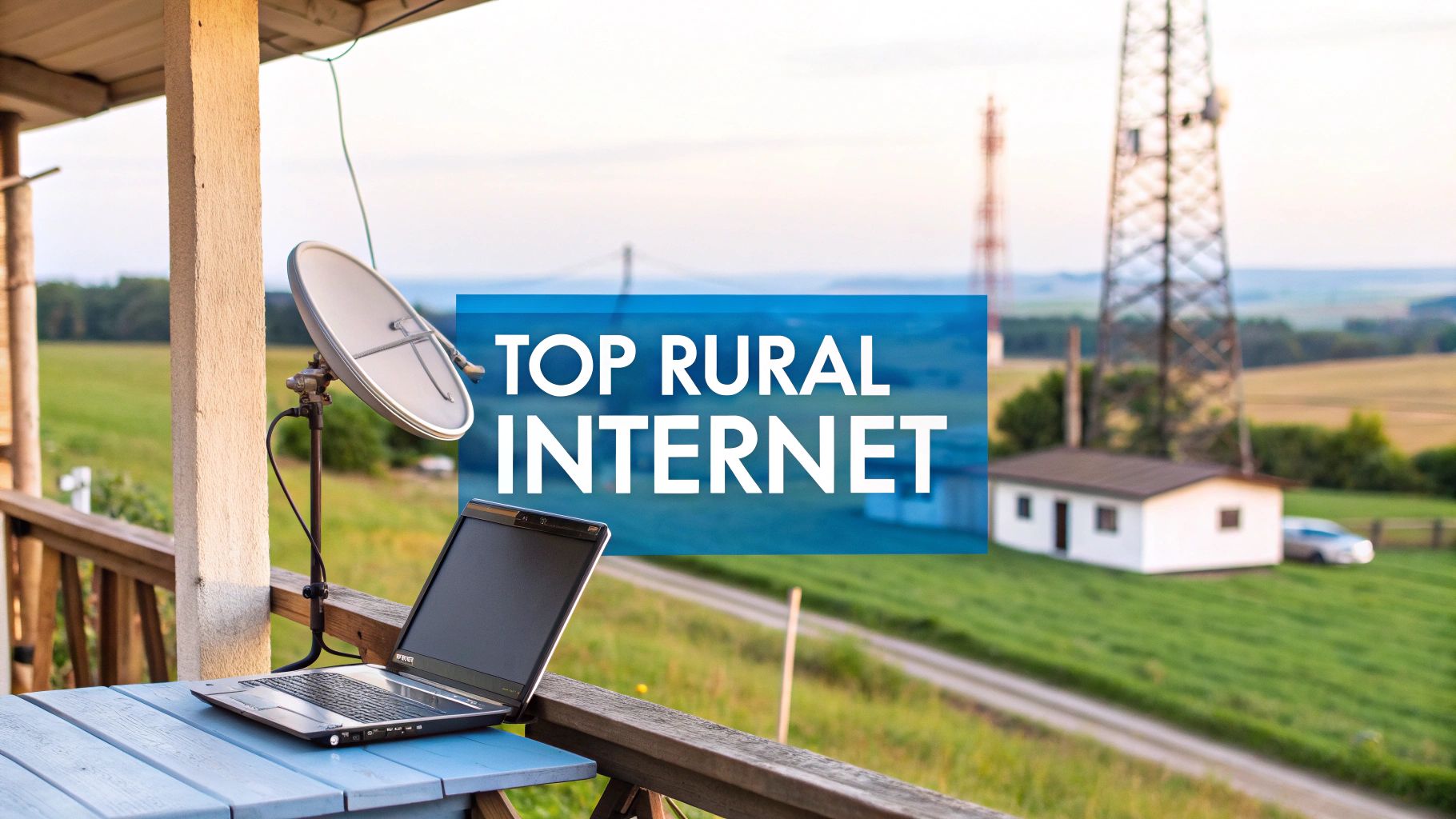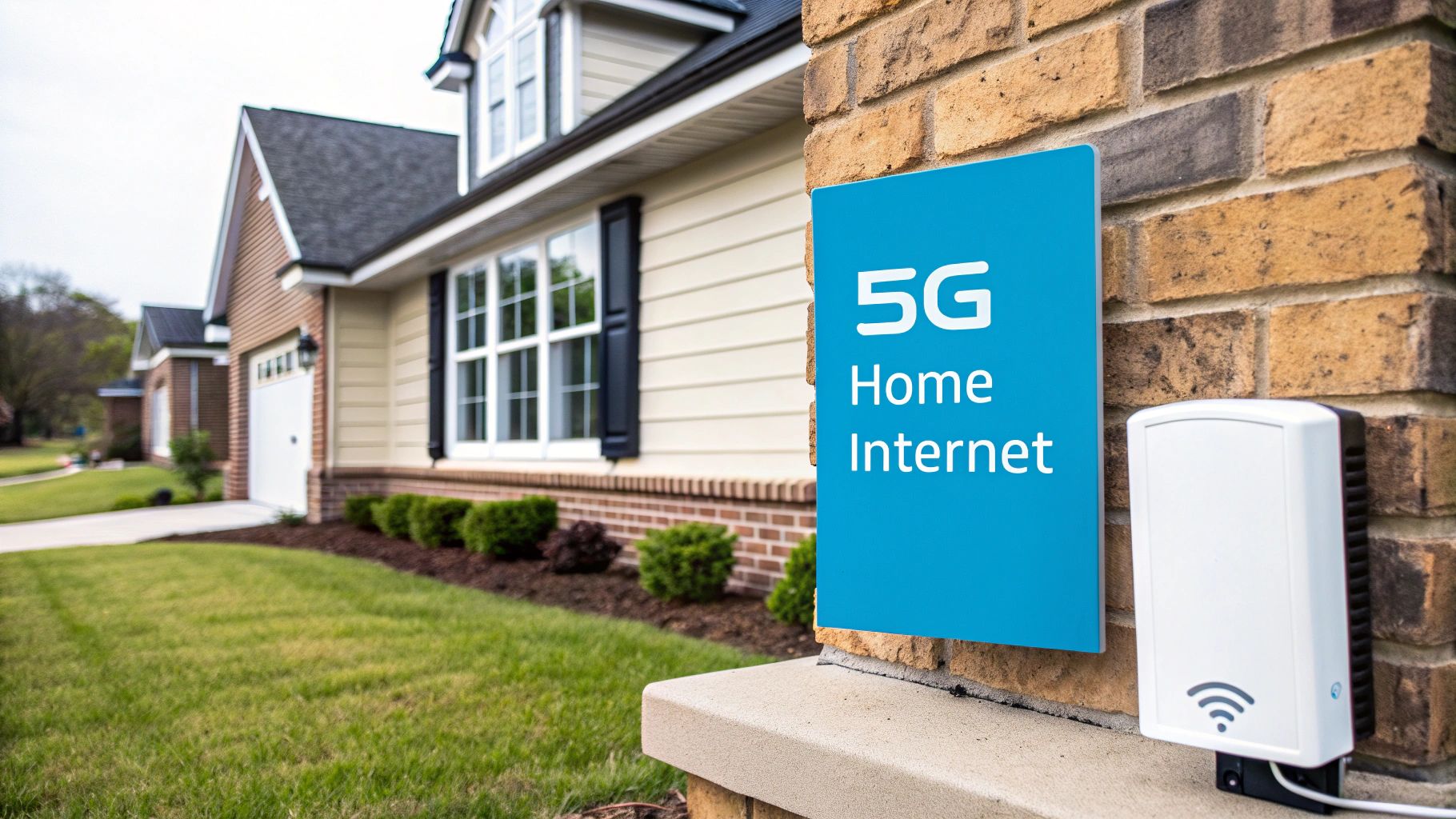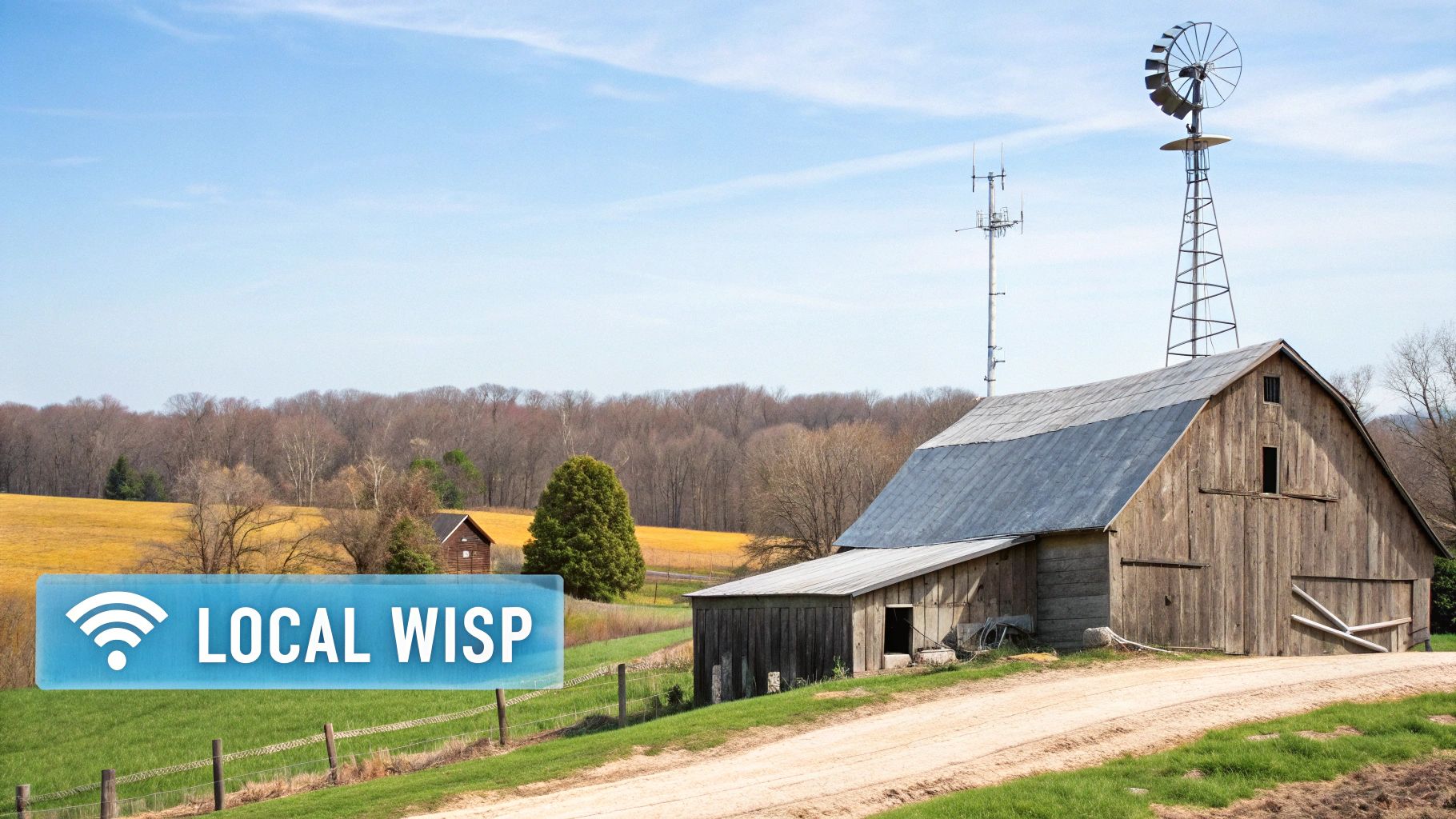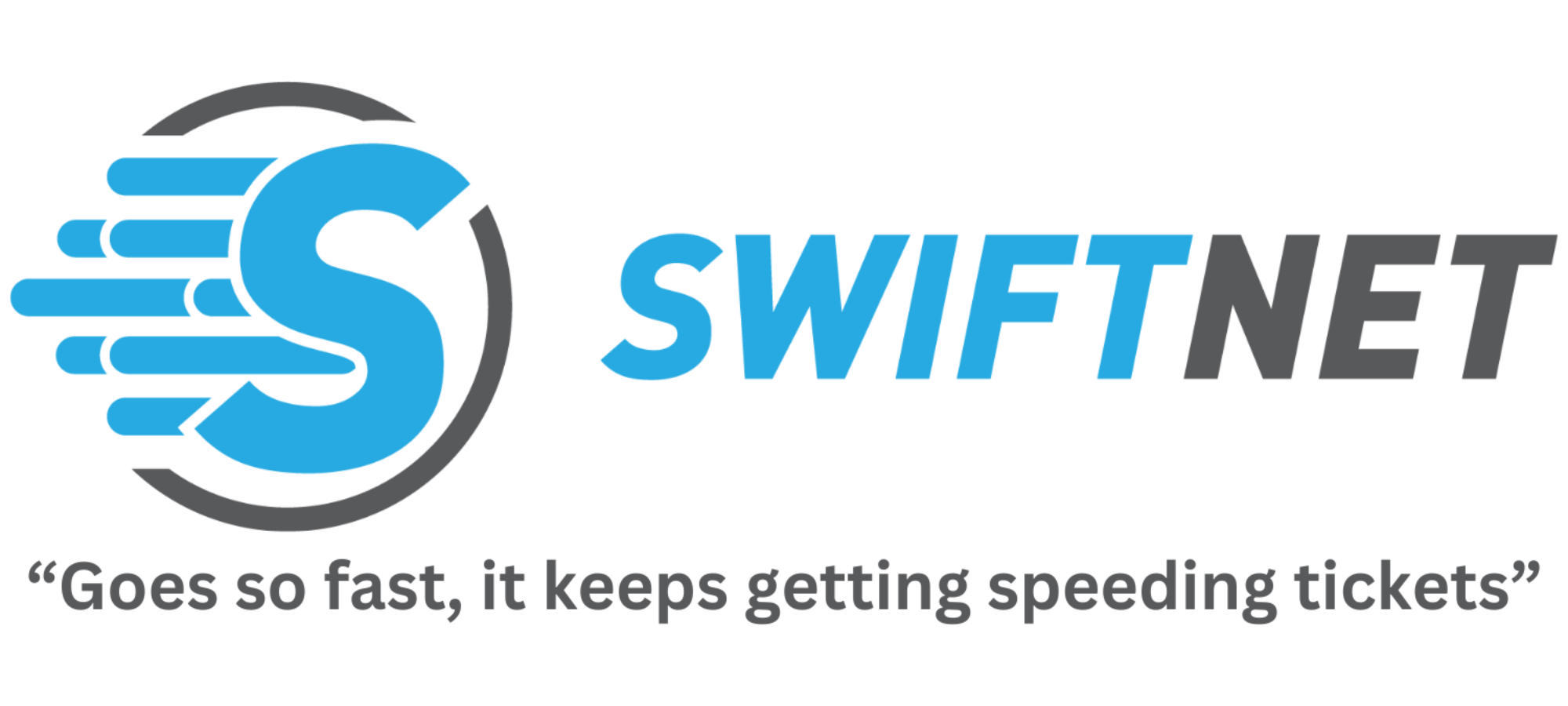

· By James
10 Best rural internet options You Should Know
Getting Started
Finding reliable internet in rural areas can be a significant challenge. This curated list explores the best rural internet options, offering actionable insights to help you choose the right connection for your needs. Whether you're an RV traveler, a remote worker, or simply live outside the reach of fiber optic cables, this guide will help you navigate the complex world of rural internet providers and technologies.
This listicle dives deep into the pros, cons, pricing, and real-world performance of each option. We'll cover everything from satellite internet providers like Starlink, HughesNet, and Viasat to emerging 5G home internet services from Verizon and T-Mobile. We'll also explore fixed wireless options like AT&T Fixed Wireless and Rise Broadband, along with DSL and fiber possibilities from providers like CenturyLink/Lumen. Finally, we'll examine the potential of local Wireless Internet Service Providers (WISPs).
This isn't just a surface-level overview. We'll provide specific, actionable tips for optimizing your chosen connection, ensuring you get the most out of your rural internet service. We understand that finding the best rural internet options requires careful consideration of various factors. That’s why we’ve compiled this comprehensive guide to provide you with the information you need to make an informed decision. Each option offers unique benefits and drawbacks, and your specific needs will determine the best fit.
Are you ready to ditch the frustratingly slow speeds and unreliable connections? Let's dive in and discover the best rural internet options available.
1. Starlink Satellite Internet
Starlink, a project by SpaceX, delivers high-speed internet through a network of low Earth orbit (LEO) satellites. Unlike traditional satellite internet, Starlink's constellation of satellites orbits closer to Earth, resulting in significantly reduced latency and increased speeds, making it a viable option for rural internet access. This innovative approach has bridged the digital divide for many, from remote workers to rural schools. For those seeking reliable internet in areas lacking traditional infrastructure, Starlink offers a compelling solution.
Examples of Starlink's impact are numerous. Emergency services in remote Alaska maintain crucial communication lines. Rural schools in Montana connect students to online learning platforms. Farmers in Nebraska leverage precision agriculture tools, increasing efficiency and yields. Remote workers in Wyoming participate in seamless video conferences. These diverse use cases showcase Starlink's versatility and potential.
For optimal performance, consider the following:
- Use the Starlink app to identify potential obstructions before installation.
- Mount the dish clear of trees to prevent future signal blockage due to growth.
- Explore backup power solutions for uninterrupted service during outages.
- Monitor data usage initially to understand consumption patterns and manage your plan effectively.
- Join local Starlink user groups for troubleshooting tips and community support. (starlink.com)
The following infographic summarizes key performance metrics for Starlink:

As a quick reference, the infographic above visually highlights download speeds of 25-220 Mbps, upload speeds of 5-20 Mbps, and latency between 20-40 ms. These metrics place Starlink's performance significantly above traditional satellite internet and often comparable to, or exceeding, DSL and some fixed wireless options, making it a truly competitive option for rural internet best rural internet options.
2. Verizon 5G Home Internet
Verizon 5G Home Internet offers fixed wireless access, leveraging Verizon's 5G Ultra Wideband network. This technology delivers high-speed internet to homes via radio waves, eliminating the need for traditional cable installations. By utilizing mmWave and C-band spectrum, Verizon 5G Home Internet provides fiber-like speeds without requiring physical fiber optic lines, making it one of the best rural internet options available. This makes it a viable option for those seeking reliable internet access in rural locations.

Examples of where Verizon 5G Home Internet excels include suburban communities on the edges of cities, small towns near major highways with 5G towers, and rural businesses located near interstate corridors. It's also an excellent option for areas with existing 5G coverage but limited cable infrastructure. To learn more about how 5G is expanding rural internet access, check out this insightful article: Learn more about Verizon 5G Home Internet and its impact on rural connectivity.
For optimal performance with Verizon 5G Home Internet, consider these tips:
- Check Verizon's coverage map thoroughly before placing an order to ensure service availability at your specific location.
- Test the signal strength at different locations inside your home to pinpoint the area with the strongest and most consistent signal.
- Experiment with window placement for the 5G receiver to optimize signal reception.
- Monitor your internet speeds at various times of the day to understand how peak usage periods might affect performance.
- If speeds consistently fall short of expectations, contact Verizon's customer support for assistance.
3. T-Mobile 5G Home Internet
T-Mobile 5G Home Internet offers fixed wireless broadband leveraging T-Mobile's extensive 5G network, including mid-band and high-band spectrum. Designed for underserved areas, it aims to compete with traditional broadband by utilizing the carrier's broad rural network footprint. This presents a viable "best rural internet options" solution where other technologies falter. This makes it an attractive option for those seeking reliable internet access beyond the reach of cable or fiber.
T-Mobile 5G Home Internet has seen success across diverse rural settings. Rural farming communities in Iowa now enjoy consistent speeds above 50 Mbps, enabling precision agriculture and remote farm management. Mountain towns in Colorado with limited cable options finally have access to reliable high-speed internet. Small businesses in Texas have replaced sluggish DSL connections with T-Mobile 5G, boosting productivity. Remote workers in Maine leverage the service to seamlessly access cloud-based applications.
For optimal performance with T-Mobile 5G Home Internet, consider these tips:
- Experiment with different gateway locations within your home to find the strongest signal.
- Take advantage of T-Mobile's test drive program, if available, to evaluate the service before committing.
- Monitor performance consistently over several weeks to understand typical speeds and reliability in your area.
- Consider an external antenna if your signal is weak, especially in areas with challenging terrain or dense foliage.
- Compare the 5G Home Internet performance with your local T-Mobile mobile signal strength, as it can be a good indicator of potential fixed wireless performance. (t-mobile.com)
As a competitive option among the best rural internet options, T-Mobile 5G Home Internet offers a practical solution for those seeking an alternative to traditional broadband in underserved areas. Its reliance on the expanding 5G network positions it for continued improvement and wider availability, bridging the digital divide for rural communities.
4. HughesNet Satellite Internet
HughesNet, a long-standing provider, delivers satellite internet from geostationary satellites positioned 22,000 miles above Earth. This technology makes HughesNet a widely available option for rural areas lacking terrestrial broadband, although the distance to the satellites introduces inherent latency. HughesNet focuses on providing coverage specifically to those in remote locations where other best rural internet options are unavailable.
HughesNet's impact in bridging the digital divide is evident in diverse scenarios. Remote cabins in Alaska maintain basic internet connectivity. Farms in rural Kansas access crucial weather and commodity data. RV travelers utilize portable satellite dishes for internet access on the go. Even critical rural services rely on HughesNet as emergency backup internet. These examples highlight HughesNet's broad reach and importance in underserved areas.
For optimal performance with HughesNet, consider the following:
- Schedule large downloads during Bonus Zone hours (2 AM - 8 AM) for faster speeds and reduced impact on daytime usage.
- Use data compression tools to maximize your data allowance and improve browsing speeds.
- Position the satellite dish with a clear view of the southern sky to ensure optimal signal reception.
- Consider weather protection for the dish installation to maintain service reliability in harsh conditions.
- Monitor data usage closely to avoid overage charges and manage your plan effectively. (hughesnet.com)
HughesNet stands as one of the largest satellite internet providers in the US, specifically designed for rural connectivity. While its performance may not match the speeds of newer LEO satellite options, its widespread availability makes it a viable choice for many. If HughesNet is your only option, implementing these tips can help improve performance and maximize your data usage.
5. Viasat Satellite Internet
Viasat, a long-standing satellite internet provider, offers high-capacity service to rural areas using advanced spot-beam technology. Unlike traditional satellite internet, Viasat utilizes focused beams to deliver higher speeds and greater bandwidth to specific geographic areas. This, coupled with their multiple satellites, including the high-capacity ViaSat-2 and newer ViaSat-3 constellation, provides a robust solution for those beyond the reach of terrestrial internet options. For those seeking reliable internet in areas lacking traditional infrastructure, Viasat offers a strong, if potentially costly, option.
Viasat's impact is evident in various rural settings. Rural businesses in Montana run cloud-based POS systems efficiently, while remote educational facilities stream high-quality video content without buffering. Agricultural operations leverage Viasat for IoT monitoring systems, enabling real-time data analysis for improved decision-making. Even telehealth services in underserved communities rely on Viasat to deliver crucial healthcare access. These examples highlight the versatility and reliability of Viasat for diverse best rural internet options.
For optimal performance with Viasat, consider these tips:
- Choose unlimited plans if you are a heavy data user, although be aware of potential speed reductions after exceeding priority data allowances.
- Understand the distinctions between priority and unlimited data to avoid surprises on your bill and manage expectations.
- Optimize streaming quality settings to conserve priority data and avoid exceeding your allowance too quickly.
- Consider bundling with voice services for potential cost savings.
- Use Quality of Service (QoS) settings on your router to prioritize critical applications like video conferencing or online gaming. (viasat.com)
As a major player in satellite internet, Viasat represents a viable option among the best rural internet options, especially for those with high data demands. While cost can be a factor, the reliability and performance make it a valuable choice in areas with limited alternatives.
6. AT&T Fixed Wireless Internet
AT&T Fixed Wireless Internet offers a broadband solution using AT&T's existing cellular network infrastructure. This makes it a viable option for rural homes and businesses beyond the reach of traditional cable or fiber lines. Leveraging 4G LTE and emerging 5G technologies, this service delivers respectable broadband speeds where other options are limited. This bridges the digital divide, connecting previously underserved areas.
This technology has proven effective in several scenarios. Rural Texas communities previously reliant on slow DSL now enjoy faster speeds. Small businesses in Georgia have replaced unreliable connections with dedicated broadband. Farmers in Oklahoma utilize precision agriculture tools through fixed wireless. Even remote offices maintain seamless corporate network access. These examples demonstrate the technology's versatility and impact.
For optimal performance with AT&T Fixed Wireless Internet, consider these tips:
- Check signal strength at your location before committing to the service.
- Position the receiver near windows facing the nearest cell towers for optimal signal.
- Monitor data usage to avoid overage charges, especially with data-intensive applications.
- Consider an external antenna for boosting signal strength in areas with weak reception.
- Compare the fixed wireless signal with your local AT&T mobile signal as a baseline performance indicator. (att.com)
As a best rural internet option, AT&T Fixed Wireless Internet is particularly valuable for those in areas without wired broadband infrastructure. It presents a practical alternative to satellite internet, often offering better latency and competitive speeds. While data caps and signal strength variations can be considerations, its ease of installation and reliance on established cellular infrastructure make it a valuable option for many rural internet users.
7. Rise Broadband Fixed Wireless
Rise Broadband delivers fixed wireless internet service to rural and underserved areas across 16 states. Utilizing point-to-point and point-to-multipoint wireless technology, Rise Broadband leverages licensed and unlicensed spectrum to provide broadband access without the need for traditional cable infrastructure. This makes it a viable option for best rural internet options where other solutions are limited. For those beyond the reach of fiber or cable, fixed wireless offers a practical connection.
Rise Broadband's impact is evident in diverse rural settings. Rural communities nestled in the Colorado mountains now enjoy internet speeds of 25+ Mbps. Small towns in Texas have replaced inadequate DSL connections with Rise Broadband's reliable service. Agricultural businesses in Nebraska utilize the network to run modern operations efficiently. Rural schools across its service area leverage Rise Broadband to access essential educational resources online.
For a successful fixed wireless experience with Rise Broadband, consider these key points:
- Verify line-of-sight requirements between your location and the nearest tower before installation.
- Ask about tower locations and expected signal strength at your specific address.
- Understand installation requirements, including roof access for the receiving equipment.
- Compare local plan options and pricing to find the best fit for your needs.
- Inquire about business plans if you plan to work from home regularly. (risebroadband.com)
Rise Broadband offers a practical solution for those seeking best rural internet options in areas lacking traditional infrastructure. Its fixed wireless approach makes it a competitor among DSL, satellite, and other rural internet providers.
8. Windstream Kinetic Internet
Windstream Kinetic Internet offers a mix of DSL, fiber, and fixed wireless services, catering specifically to the needs of rural communities. Focusing on small towns and underserved areas, Windstream leverages both established and emerging technologies to provide reliable broadband where other providers often fall short. This makes them a key player in bridging the digital divide for many rural residents and businesses. For those exploring best rural internet options, Windstream Kinetic is worth investigating. Learn more about other rural internet options for remote areas.
Real-world examples showcase Windstream's impact. Small towns in Arkansas are now experiencing the benefits of fiber-to-the-home, enabling faster speeds and greater bandwidth. Rural businesses in Georgia rely on DSL for essential connectivity, supporting daily operations. Agricultural operations in Alabama leverage Windstream's services to access critical online resources. Even rural healthcare facilities maintain vital communication lines thanks to Windstream's network reach. Learn more about Windstream Kinetic Internet and other options for rural internet access.
For optimal service and to determine if Windstream Kinetic is right for you, consider the following:
- Verify which technology (DSL, fiber, or fixed wireless) is available at your precise location, as availability and speeds can vary.
- Inquire about fiber expansion plans if fiber isn't currently offered in your area. Future upgrades may be on the horizon.
- Compare DSL speeds offered by Windstream with satellite internet alternatives to ensure you're getting the best value for your needs.
- If you work from home, inquire about business plans, as they often come with enhanced service level agreements and priority support.
- Carefully review service level agreements and understand the available support options before committing to a plan.
These steps will help ensure you make an informed decision about your rural internet connectivity.
9. CenturyLink/Lumen DSL and Fiber
CenturyLink, now operating as Lumen Technologies, is an established telecommunications provider offering DSL and fiber internet services, particularly in rural markets. While Lumen's focus has shifted towards enterprise services, it continues to provide residential broadband in many rural communities across 36 states, offering a familiar option for those seeking best rural internet options. This makes them a relevant consideration for those exploring the best rural internet options. For many rural residents, CenturyLink remains a primary or backup internet source.
Examples of CenturyLink/Lumen's presence are widespread. Rural communities in Montana rely on legacy DSL service for basic connectivity. Small towns in Washington state are seeing fiber upgrades, bringing high-speed internet access. Farms in Minnesota utilize DSL for essential internet needs. Rural businesses maintain crucial voice and data services through CenturyLink/Lumen. These examples highlight the company's continued role in connecting rural America.
For those considering CenturyLink/Lumen, the following tips are crucial:
- Check if fiber is available or planned for your area, as fiber offers significant speed and reliability advantages over DSL.
- Understand DSL speed limitations are based on distance from the central office; the farther away, the slower the speeds.
- Take advantage of "Price for Life" guarantees where available for predictable budgeting.
- Monitor service quality and report persistent issues to ensure optimal performance.
- Consider CenturyLink/Lumen DSL as a backup option if your primary internet service fails. (centurylink.com)
As a long-standing provider, CenturyLink/Lumen offers familiar options for rural internet users. Understanding their service offerings, potential limitations, and available guarantees can help you determine if it's the right fit for your rural internet needs.
10. Local Wireless Internet Service Providers (WISPs)
Local Wireless Internet Service Providers (WISPs) offer a compelling solution for rural internet best rural internet options. These smaller, local companies leverage fixed wireless technology, transmitting internet signals point-to-point or point-to-multipoint across a specific community. This approach effectively fills the gaps often left by larger providers, offering a tailored service experience. WISPs frequently understand the unique challenges of rural connectivity and provide personalized support. They are a valuable resource for those seeking reliable best rural internet options beyond the reach of mainstream infrastructure.

Examples of successful WISPs include Nextlink Internet serving rural Texas and Oklahoma, and Pioneer Communications in rural Oklahoma and Kansas. JROC Networks focuses on communities in Texas, while numerous local cooperatives bundle internet service with electricity. Even specialized WISPs cater to specific niche markets, like those serving Colorado ski communities. This localized approach allows WISPs to address the specific needs of their service areas effectively. Learn more about Local Wireless Internet Service Providers (WISPs) at this related article.
For those exploring WISP options, consider the following:
- Community Research: Leverage community forums and word-of-mouth to identify local providers and gather feedback. Ask neighbors about their experiences.
- Installation: Inquire about specific installation requirements and line-of-sight necessities, which are crucial for fixed wireless connections.
- Local Support: Understand their support hours and emergency response protocols, as local support is a key WISP advantage.
- Comparison Shopping: Compare pricing and contract terms with larger national providers to ensure a competitive offering.
- Technical Capabilities: Verify their technical capabilities meet your specific internet usage needs, such as video conferencing or online gaming.
Top 10 Rural Internet Options Comparison
| Internet Service Provider | Implementation Complexity 🔄 | Resource Requirements ⚡ | Expected Outcomes 📊 | Ideal Use Cases 💡 | Key Advantages ⭐ |
|---|---|---|---|---|---|
| Starlink Satellite Internet | Moderate (self-install dish antenna, clear sky) | High (costly equipment, power consumption) | High speeds (25-220 Mbps), low latency (20-40ms) | Rural/remote areas with clear sky, no other high-speed options | Wide coverage, low latency, no data caps |
| Verizon 5G Home Internet | Low (self-setup gateway) | Moderate (requires strong 5G signal coverage) | Very high speeds (up to 1 Gbps), reliable where available | Suburban/rural near 5G towers, users needing fiber-like speeds | Fast setup, no contracts, mobile plan discounts |
| T-Mobile 5G Home Internet | Low (simple gateway setup) | Moderate (uses 5G & 4G LTE coverage) | Moderate speeds (25-110 Mbps), consistent pricing | Rural and suburban areas with T-Mobile coverage | Wide availability, no data caps, easy setup |
| HughesNet Satellite Internet | High (professional installation) | Moderate to high (data capped, equipment & contracts) | Speeds up to 25 Mbps, high latency (600-700 ms) | Rural US areas without terrestrial broadband | Nationwide availability, reliable connection |
| Viasat Satellite Internet | High (professional install, costly equipment) | High (expensive plans, contracts) | Higher speeds (up to 150 Mbps), high latency | Rural businesses and heavy data users needing higher capacity | Unlimited data plans, advanced satellite tech |
| AT&T Fixed Wireless Internet | Moderate (self or professional install) | Moderate (dependent on cellular coverage) | Speeds up to 50 Mbps, variable reliability | Rural homes/businesses within AT&T network coverage | Bundling options, no cable needed |
| Rise Broadband Fixed Wireless | Moderate (professional installation required) | Moderate (line-of-sight needed, local towers) | Speeds up to 50 Mbps, no data caps on most plans | Rural and underserved areas with line-of-sight to towers | No data caps, local support |
| Windstream Kinetic Internet | Variable (depends on tech: DSL, fiber, wireless) | Moderate (varies by technology) | Speeds 25 Mbps to 1 Gbps, no data caps mostly | Small towns & rural focused areas | Multiple tech options, local service |
| CenturyLink/Lumen DSL and Fiber | Moderate (existing infrastructure) | Low to moderate (mainly copper DSL or fiber) | Speeds 1.5 Mbps to 940 Mbps, stable with fiber option | Rural communities with existing infrastructure | Price lock guarantee, no contracts |
| Local WISPs | Moderate to high (varies by provider & tech) | Low to moderate (localized infrastructure) | Speeds 5-100 Mbps, variable reliability | Specific rural communities needing personalized service | Personalized local support, flexible plans |
Final Thoughts
Finding the best rural internet options can feel like navigating a complex maze. This guide has explored ten prominent choices, from satellite internet giants like Starlink, HughesNet, and Viasat to emerging 5G home internet from Verizon and T-Mobile. We've also looked at fixed wireless options like AT&T and Rise Broadband, along with DSL and fiber options where available from providers like CenturyLink/Lumen and the crucial role of local WISPs. Each option offers a unique blend of speeds, data allowances, and price points, catering to different needs and budgets.
Key Takeaways for Choosing Rural Internet
Choosing the right internet boils down to understanding your specific requirements. Consider these key factors:
- Data Usage: How much data do you consume monthly? Heavy streamers and online gamers will need higher data caps than casual browsers.
- Speed Requirements: Video conferencing, online gaming, and large file downloads demand faster speeds. Consider your daily online activities.
- Budget: Balance performance with affordability. Explore different plans and providers to find the best value.
- Availability: Not all services are available everywhere. Check coverage maps for your specific location.
- Reliability: Research customer reviews and consider potential outages due to weather or technical issues.
Empowering Your Rural Connection
Mastering these concepts empowers you to make an informed decision and optimize your online experience. Reliable internet access is no longer a luxury, but a necessity for remote work, education, entertainment, and staying connected. Whether you're an RV traveler seeking connectivity on the road or a rural resident needing reliable internet for work, the right choice can transform your digital life.
Next Steps to Secure Your Best Rural Internet
- Assess your needs: Determine your data usage, speed requirements, and budget.
- Check availability: Use provider websites to verify service availability at your location.
- Compare plans: Evaluate different plans and providers based on your needs and budget.
- Read reviews: Research customer experiences and potential issues.
- Contact providers: Reach out to providers directly to discuss options and ask questions.
The ideal internet solution for you depends on your individual circumstances and location. By carefully considering these factors and actively researching available options, you can secure the best rural internet connection to meet your specific needs.
Don't let a weak internet connection slow you down. Boost your rural internet experience with SwiftNet Wifi, a powerful and versatile solution designed to optimize your online connectivity, wherever your adventures take you. Visit SwiftNet Wifi to learn more about how SwiftNet can help you stay connected on the go.

